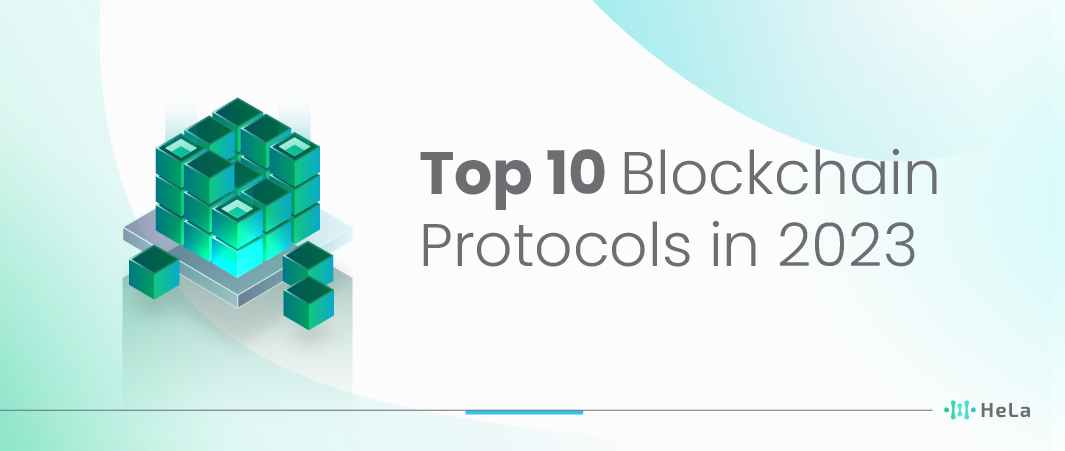In the rapidly evolving world of blockchain technology, 2025 continues to witness significant innovation and growth. Let’s explore the “Top 10 Blockchain protocols 2025” to gain insights into their distinctive features, real-world applications, and reasons for their prominence in the competitive landscape.
Furthermore, emerging blockchain entrants are also making significant strides. These newcomers are known for their unique features, such as customizable blockchains, stablecoins for cross-border commerce, high-speed transactions with low fees, on-chain governance, and support for non-fungible tokens (NFTs). The combined strengths of these platforms promise a bright future for blockchain technology throughout 2025 and beyond, driving innovation across various sectors.
The Evolving Landscape of Blockchain Technology

The blockchain technology landscape has been in a state of rapid evolution over the past decade. Since its inception with Bitcoin in 2009, blockchain has evolved far beyond its original use case as a digital currency. It has found applications in various industries, from finance and supply chain management to healthcare and entertainment.
One of the most significant trends in 2024 is the growing integration of blockchain into mainstream business operations. Companies across different sectors are recognizing the potential of blockchain to enhance transparency, security, and efficiency. This has led to increased investment in blockchain research and development, as well as the creation of various consortia and alliances aimed at advancing the technology.
Moreover, the regulatory landscape surrounding blockchain is also evolving. Governments and regulatory bodies are actively working to establish frameworks and guidelines for the responsible use of blockchain technology. This regulatory clarity is essential for businesses and investors, as it helps reduce uncertainty and fosters trust in the technology.
Also Read: Blockchain Penetration Testing: Methods for Secure Blockchain Applications
Interoperability is another key focus area in the blockchain industry. As more blockchain platforms and networks emerge, the need for them to communicate and share data becomes increasingly important. Projects and initiatives aimed at achieving blockchain interoperability are gaining traction, as they hold the potential to unlock new opportunities for collaboration and innovation.
Additionally, environmental concerns have come to the forefront in the blockchain space. The energy consumption of some blockchain networks, particularly proof-of-work-based systems like Bitcoin, has raised questions about their sustainability. This has prompted a shift towards more environmentally friendly consensus mechanisms, such as proof-of-stake and hybrid models, in the development of new blockchain platforms.
Evaluating the Criteria for Selection
Before delving into the specifics of each blockchain protocol, it’s essential to establish the criteria used for their selection. In this section, we will outline the factors considered when ranking these platforms, such as scalability, security, decentralization, real-world adoption, and developer community support. These criteria provide a fair and objective basis for our rankings, ensuring that we thoroughly assess each platform’s suitability for various applications and use cases.
Scalability
Scalability is a critical factor, as it determines a blockchain’s capacity to handle a growing number of transactions and users. We will evaluate how each platform addresses scalability challenges and whether it offers solutions like sharding, layer-2 protocols, or other scaling mechanisms.
Security
Security is paramount in the blockchain space, given the potential for financial and data-related risks. We will assess the security features and track records of each platform, including their consensus algorithms, immutability, and resistance to attacks.
Decentralization
The level of decentralization plays a significant role in blockchain protocols. We will examine the governance models, node distribution, and consensus mechanisms to gauge the platforms’ commitment to decentralization and resilience against censorship or control by a central authority.
Real-world Adoption
The practical application of blockchain technology is crucial. We will analyze the platforms’ real-world adoption, partnerships with businesses, government agencies, and the extent to which they are used for various applications, such as finance, supply chain, healthcare, or identity management.
Developer Community Support
A thriving developer community is indicative of a healthy and evolving blockchain ecosystem. We will consider factors like the availability of developer tools, documentation, and the developer community’s activity and contributions.
By evaluating these criteria, we aim to provide a comprehensive assessment of each blockchain platform’s strengths and weaknesses. This analysis will assist readers in making informed decisions when selecting a blockchain protocol that aligns with their specific needs and objectives.
Top 10 Blockchain Protocols to Know in 2025

In 2025, the blockchain ecosystem has matured from a volatile frontier to a sophisticated digital economy fueling decentralized finance (DeFi), AI, gaming, identity, and cross-border commerce. Amid thousands of chains and layer-2 networks, a select few protocols have emerged as foundational pillars of Web3.
Whether you’re a developer building dApps, an investor tracking market leaders, or simply blockchain-curious, these are the Top 10 Blockchain Protocols you need to know in 2025.
1. HeLa Chain (HeLa)
HeLa Chain exploded in 2024 by bridging the gap between decentralized physical infrastructure networks (DePIN), AI, and real-world compute. Built as a modular Layer-1 and integrated with zero-knowledge (ZK) proofs, HeLa enables verifiable off-chain computation and secure AI model execution.
Highlights:
HeLa VM: A computation-first virtual machine optimized for heavy workloads like machine learning and real-time IoT data streams.
Cross-chain orchestration: Natively supports Ethereum, Solana, and Cosmos ecosystems through trustless bridges.
ZK-AI: Enables verifiable AI inference, giving birth to fully decentralized AI assistants and analytics.
Use Cases:
Decentralized ride-sharing, drone delivery networks.
Transparent AI decision-making in DeFi risk assessment.
Monetizing unused GPU/CPU resources.
2. Chainlink (LINK)
Chainlink remains the industry’s leading decentralized oracle network, connecting smart contracts with real-world data. Its architecture enables secure and reliable data feeds across blockchains, fueling use cases from DeFi to insurance.
Highlights:
- Cross-Chain Interoperability Protocol (CCIP): A universal messaging and value transfer layer that connects different blockchains and traditional systems.
- Proof of Reserve & Data Feeds: Powering price oracles, weather data, and asset tracking for top DeFi projects.
- Staking v0.2: Strengthens network reliability by incentivizing node operators through reputation and rewards.
Use Cases:
- Reliable price feeds for decentralized lending and derivatives.
- Secure bridging between enterprise APIs and on-chain smart contracts.
3. Stellar (XLM)
Stellar focuses on cross-border payments and financial inclusion by providing a fast, low-cost platform for transferring value. The Stellar network connects banks, fintechs, and payment providers, reducing friction in remittances and settlements.
Highlights:
- Soroban Smart Contracts: Expands Stellar’s functionality to support DeFi and programmable assets.
- Anchor Network: Bridges fiat currencies to blockchain through regulated partners.
- Carbon-Neutral Design: Prioritizes sustainability with low energy consumption per transaction.
Use Cases:
- Cross-border remittances between emerging markets.
- Tokenization of stablecoins and real-world assets (RWAs) by financial institutions.
4. Hedera (HBAR)
Hedera Hashgraph introduces a high-performance distributed ledger built on its unique gossip-about-gossip protocol. It’s designed for enterprise-grade scalability and fairness, with predictable low fees and high throughput.
Highlights:
- Hashgraph Consensus: An alternative to traditional blockchain providing asynchronous Byzantine Fault Tolerance (aBFT).
- Governing Council: Includes global corporations like Google, IBM, and LG, ensuring governance stability.
- Hedera Token Service (HTS): Enables efficient tokenization with built-in compliance tools.
Use Cases:
- Supply chain provenance tracking for luxury goods and pharmaceuticals.
- Micropayments for content streaming and IoT data exchange.
5. Avalanche (AVAX)
Avalanche leaned into custom subnets and nailed it. In 2025, it’s the protocol of choice for institutions, game studios, and even countries launching CBDCs.
Highlights:
Subnets allow developers to launch app-specific chains with custom rules.
Evergreen Subnets serve regulated finance like tokenized bonds and stock markets.
Avalanche Warp Messaging (AWM) allows seamless messaging across subnets.
Use Cases:
GameFi, institutional DeFi, CBDCs, and regulated token offerings.
6. Ondo Finance (ONDO)
Ondo is pioneering the tokenization of real-world assets (RWA) by bringing traditional yield-bearing instruments on-chain. Its products bridge the gap between DeFi liquidity and institutional-grade financial instruments.
Highlights:
- U.S. Treasury Tokenization: Offers on-chain access to short-term Treasury yields through tokenized funds like OUSG.
- Ondo Global Markets: Connects regulated institutions to DeFi investors via permissioned liquidity pools.
- ONDO Token Utility: Supports governance and incentivizes ecosystem participation.
Use Cases:
- On-chain exposure to U.S. Treasuries for stable yield strategies.
- Institutional DeFi adoption through compliant liquidity layers.
7. Algorand (ALGO)
Algorand is a pure proof-of-stake blockchain focused on speed, security, and sustainability. It offers instant finality and high throughput, making it ideal for enterprise and government-grade solutions.
Highlights:
- Pure Proof-of-Stake (PPoS): Randomly selects validators, ensuring fairness and decentralization.
- State Proofs: Enables trustless interoperability with external chains.
- Green Blockchain: Carbon-negative since inception, with low energy usage.
Use Cases:
- Central bank digital currencies (CBDCs) and payment rails.
- Tokenization of real estate, carbon credits, and digital identity systems.
8. Tether Gold (XAUT)
Tether Gold bridges the traditional value of gold with blockchain efficiency. Each token represents ownership of one troy ounce of physical gold held in secure Swiss vaults, combining stability with digital liquidity.
Highlights:
- Fully Backed Reserves: Each XAUT is redeemable for physical gold bars.
- Ethereum & TRON Integration: Provides easy transfer and storage across major chains.
- Transparency Reports: Regular attestations ensure asset verification.
Use Cases:
- An inflation hedge for crypto and fiat investors.
- Gold-backed collateral in DeFi lending protocols.
9. VeChain (VET)
VeChain specializes in blockchain-based supply chain management and enterprise-grade traceability. Its dual-token system powers transparent logistics, data verification, and product authenticity tracking.
Highlights:
- Dual Token Model (VET + VTHO): Separates value transfer from transaction fees for stable operations.
- ToolChain Platform: Enables businesses to deploy dApps without deep blockchain knowledge.
- Enterprise Partnerships: Collaborations with Walmart China, BMW, and PwC.
Use Cases:
- Product authentication and anti-counterfeiting for luxury goods.
- Carbon footprint tracking and ESG data management.
10. PAX Gold (PAXG)
PAX Gold merges blockchain transparency with physical gold ownership. Issued by Paxos Trust Company, each PAXG token represents one fine troy ounce of London Good Delivery gold stored in Brinks vaults.
Highlights:
- Regulated Custody: Overseen by the New York State Department of Financial Services (NYDFS).
- Redeemability: Holders can redeem tokens for physical gold or a cash equivalent.
- ERC-20 Compatibility: Easily integrated into DeFi platforms and exchanges.
Use Cases:
- Digital alternative to traditional gold investment.
- Collateral for stable lending and DeFi yield strategies.
Real-World Applications and Use Cases
Blockchain technology is making a significant impact on various sectors by providing transparency, security, and efficiency in different applications. Here are some real-world use cases and applications of blockchain platforms:
Supply Chain Management
Blockchain enables end-to-end visibility and traceability in supply chains. Companies can track the movement of goods from the manufacturer to the end consumer, ensuring authenticity and reducing the risk of counterfeit products. This is particularly valuable in industries such as food and pharmaceuticals, where product safety and authenticity are paramount.
Financial Services
Blockchain is disrupting the financial industry by providing faster and more secure transactions. It is used for cross-border payments, reducing the time and cost associated with international transfers. Additionally, blockchain has given rise to cryptocurrencies like Bitcoin and Ethereum, which are changing the way people store and transfer value.
Healthcare
In the healthcare sector, blockchain is used to secure patient data, ensure the integrity of medical records, and facilitate interoperability among different healthcare providers. Patients have more control over their health data and can grant access to healthcare professionals securely.
Voting Systems
Some governments and organizations are exploring blockchain for secure and transparent voting systems. Blockchain can prevent voter fraud and ensure the accuracy of election results, leading to more trustworthy and inclusive elections.
Smart Contracts
Blockchain protocols like Ethereum enable the creation of smart contracts, self-executing agreements with predefined rules and conditions. These contracts automate processes in various industries, including legal, insurance, and real estate, reducing the need for intermediaries.
Real Estate
Blockchain simplifies property transactions by providing a transparent and immutable record of ownership. This reduces fraud in real estate deals and streamlines the buying and selling process.
Energy Trading
Blockchain can be used for peer-to-peer energy trading, allowing individuals and businesses to buy and sell excess renewable energy directly to one another, reducing reliance on centralized energy providers.
Intellectual Property Protection
Artists, writers, and content creators can use blockchain to prove ownership of their work, making it easier to protect intellectual property and receive fair compensation for their creations.
Automotive Industry
Blockchain helps in tracking the history of used cars, reducing the risk of odometer fraud and providing potential buyers with accurate information about the vehicle’s history.
Charity and Aid
Blockchain can enhance transparency in charitable donations by enabling donors to track how their contributions are used and ensuring funds reach their intended recipients in humanitarian aid efforts.
Identity Verification
Blockchain can provide a secure and decentralized method for verifying identities, reducing identity theft and fraud. Individuals can have control over their personal information.
Food Safety
In the food industry, blockchain helps in quickly identifying the source of contamination in case of foodborne illnesses, allowing for faster recalls and improved food safety measures.
These real-world applications showcase the versatility and potential of blockchain technology to disrupt and improve various sectors, offering solutions to longstanding challenges and creating new opportunities for innovation. As blockchain continues to evolve, its impact on industries will likely expand even further.
Challenges and Future Prospects

While blockchain technology holds immense promise, it also faces its fair share of challenges. In this section, we’ll discuss some of the hurdles that blockchain platforms need to overcome to reach their full potential. Additionally, we’ll look into the future prospects of blockchain technology, exploring potential developments and innovations on the horizon.
Challenges
- Scalability: One of the foremost challenges facing blockchain technology is scalability. Traditional blockchains like Bitcoin and Ethereum have struggled to handle a growing number of transactions efficiently. As adoption continues to increase, the need for faster and more scalable solutions becomes paramount.
- Energy Consumption: Proof-of-work (PoW) consensus mechanisms, used by some prominent blockchains, have drawn criticism for their significant energy consumption. This environmental concern has prompted the search for more eco-friendly consensus mechanisms like proof-of-stake (PoS).
- Interoperability: Different blockchain networks often operate in isolation, making it difficult for them to communicate and share data. Achieving interoperability between various blockchain protocols is essential for realizing the full potential of decentralized systems.
- Regulatory Challenges: Governments and regulatory bodies worldwide are still grappling with how to classify and regulate cryptocurrencies and blockchain technology. Navigating the evolving legal landscape can be a significant hurdle for blockchain projects.
- User-Friendliness: Blockchain applications can be complex for the average user. Improving user interfaces and enhancing the overall user experience is crucial for widespread adoption.
Future Prospects
- Cross-Industry Integration: Blockchain has the potential to revolutionize various industries beyond finance, including healthcare, supply chain, and voting systems. As more use cases are explored and developed, we can expect to see blockchain integrated into a broader range of applications.
- Enhanced Privacy Solutions: Privacy concerns have led to the development of privacy-centric blockchains and advanced cryptographic techniques. In the future, we may see more robust privacy solutions that balance transparency with individual privacy rights.
- Decentralized Finance (DeFi) Growth: DeFi has gained significant traction, providing decentralized alternatives to traditional financial services. This sector is poised for continued growth, with innovations such as yield farming, lending, and decentralized exchanges evolving rapidly.
- Governance Models: Blockchain projects are experimenting with various governance models, such as decentralized autonomous organizations (DAOs). These models enable token holders to participate in decision-making, potentially leading to more democratic and transparent governance.
Also Read: What is Tokenomics? A Role in Cryptocurrency
- Interconnected Blockchains: Solutions like Polkadot and Cosmos aim to create networks of interconnected blockchains, enabling seamless data and asset transfers between different chains. This could pave the way for a more interconnected and efficient blockchain ecosystem.
- Enterprise Adoption: As blockchain technology matures and regulatory clarity improves, more enterprises are likely to adopt blockchain solutions for efficiency, transparency, and cost savings. This could lead to large-scale implementations across industries.
- Quantum-Resistant Blockchains: With the development of quantum computers on the horizon, there is a growing need for quantum-resistant blockchain protocols to protect against potential threats to cryptographic security.
Conclusion
In conclusion, blockchain technology continues to be a driving force of innovation in 2025. The top 10 blockchain protocols we’ve discussed in this article represent the cream of the crop, each contributing to the ever-expanding ecosystem in its unique way.
As blockchain adoption continues to grow, it’s crucial to stay informed about the latest developments and trends in this dynamic field. Whether you’re a developer, investor, or simply someone curious about the technology, understanding these platforms is a valuable step in navigating the blockchain landscape of 2025.
As you explore the world of blockchain protocols further, remember that this technology has the potential to revolutionize industries, disrupt traditional systems, and create new opportunities for individuals and businesses alike. Stay curious, stay informed, and keep an eye on these top 10 blockchain protocols as they shape the future of decentralized technology.
Disclaimer: The information provided by HeLa Labs in this article is intended for general informational purposes and does not reflect the company’s opinion. It is not intended as investment advice or recommendations. Readers are strongly advised to conduct their own thorough research and consult with a qualified financial advisor before making any financial decisions.

Joshua Soriano
I am a writer specializing in decentralized systems, digital assets, and Web3 innovation. I develop research-driven explainers, case studies, and thought leadership that connect blockchain infrastructure, smart contract design, and tokenization models to real-world outcomes.
My work focuses on translating complex technical concepts into clear, actionable narratives for builders, businesses, and investors, highlighting transparency, security, and operational efficiency. Each piece blends primary-source research, protocol documentation, and practitioner insights to surface what matters for adoption and risk reduction, helping teams make informed decisions with precise, accessible content.
- Joshua Soriano#molongui-disabled-link
- Joshua Soriano#molongui-disabled-link
- Joshua Soriano#molongui-disabled-link
- Joshua Soriano#molongui-disabled-link

